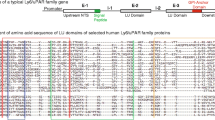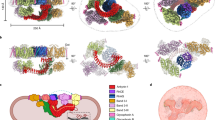Abstract
We report the molecular cloning and characterization of mouse erythrocyte protein 4.2 (P4.2). Mouse erythrocyte P4.2 is a 691-amino-acid protein with a predicted MW of 77 kDa. Northern blot analysis detected a 2.2-kb transcript in mouse reticulocytes, compared with a 2.4- to 2.5-kb transcript in human reticulocytes, which is consistent with the absence of the 30-amino-acid splicing insert in mouse erythrocyte P4.2 that is found in the human protein (isoform I). Like the human erythrocyte P4.2, mouse erythrocyte P4.2 contains regions strikingly homologous with the transglutaminase (TGase) proteins although it too most likely lacks TGase crosslinking activity. Mouse P.4.2 is on average 73% identical with human erythrocyte P4.2, although regional variations exist, with greatest conservation in the regions of the molecule that contain the TGase active site, the TGase calcium-binding site, and a band 3 binding site. Hydropathy analysis reveals a protein containing a series of hydrophobic domains, similar to the situation for human P4.2 and consistent with its tight binding to the membrane, although the mouse P4.2 is missing both the strongly hydrophilic region and adjacent highly charged region that are present in the human protein, suggesting that the two proteins could differ in their physical characteristics, binding associations, or functional properties. The availability of the complete mouse erythrocyte P4.2 cDNA should help in the design of P4.2-deficient animal models (for example, ribozyme or homologous recombinant “knockout” models) that should accelerate the understanding of P4.2 function in both erythroid and non-erythroid cells.
Similar content being viewed by others
References
Birkenmeier, C., Bloom, M.L., Barker, J.E. (1990). Preparation of a reticulocyte cDNA library from mouse: isolation of multiple overlapping clones for α and β spectrin and ankyrin by cDNA walking. Blood 76, 4a.
Bouhassira, E.E., Schwartz, R.S., Nagel, R.L., Rybicki, A.C. (1990). Protein 4.2 mRNA splicing isoforms are tissue specific and regulated during erythroid differentiation. Blood 76, 24a.
Bouhassira, E.E., Schwartz, R.S., Yawata, Y., Ata, K., Kanzaki, A., Qiu, J.J-H., Nagel, R.L., Rybicki, A.C. (1992). An alanine to threonine substitution in protein 4.2 cDNA is associated with a Japanese form of hereditary hemolytic anemia (protein 4.2NIPPON). Blood 79, 1846–1854.
Dotimas, E., Speicher, D.W., GuptaRoy, B., Cohen, C.M. (1993). Structural domain mapping and phosphorylation of human erythrocyte pallidin (band 4.2). Biochim. Biophys. Acta 1148, 19–29.
Feinberg, A.P., Vogelstein, B. (1984). A technique for radiolabeling DNA restriction endonuclease fragments to high specific activity. Anal. Biochem. 137, 266–267.
Friedrichs, B., Koob, R., Kramer, D., Drenkhahn, D. (1989). Demonstration of immunoreactive forms of erythrocyte protein 4.2 in non-erythroid cells and tissues. Eur. J. Cell Biol. 48, 121–127.
Garnier, J., Osguthorpe, D.J., Robson, B. (1978). Analysis of the accuracy and implications of simple methods for predicting the secondary structure of globular proteins. J. Mol. Biol. 120, 97–120.
Gascuel, O., Golmard, J.L. (1988). A simple method for predicting the secondary structure of globular proteins: implications and accuracy. Comput. Appl. Biosci. 4, 357–365.
Ghanem, A., Pothier, B., Marechal, J., Ducluzeau, M.T., Morle, L., Allosio, N., Feo, C., BEN Abdeladhim, A., Fattoum, S., Delaunay, J. (1990). A hemolytic syndrome associated with complete absence of red cell membrane protein 4.2 in two Tunisian siblings. Br. J. Haematol. 75, 414–420.
Ichinose, A., Hendrickson, L.E., Fujikawa, K., Davie, E.W. (1986). Amino acid sequence of the α subunit of human factor XIII. Biochemistry 25, 6900–6906.
Ideguchi, H., Nishimura, J., Nawata, H., Hamasaki, N. (1990). A genetic defect of erythrocyte band 4.2 protein associated with hereditary spherocytosis. Br. J. Haematol. 74, 347–353.
Korsgren, C., Cohen, C.M. (1988). Associations of human erythrocyte band 4.2: binding to ankyrin and to the cytoplasmic domain of band 3. J. Biol. Chem. 263, 10212–10218.
Korsgren, C., Cohen, C.M. (1990). Complete amino acid sequence and homologies of human erythrocyte membrane protein band 4.2. Proc. Natl. Acad. Sci. USA, 87, 613–617.
Korsgren, C., Cohen, C.M. (1991). Organization of the gene for human erythrocyte membrane protein 4.2: structural similarities with the gene for the α subunit of factor XIII. Proc. Natl. Acad. Sci. USA 88, 4840–4844.
Kozak, M. (1987) An analysis of 5′-noncoding sequences from 699 vertebrate messenger RNAs. Nucleic Acids Res. 15, 8125–8148.
Kyte, J., Doolittle, R.F. (1982). A simple method for displaying the hydropathic character of a protein. J. Mol. Biol. 157, 105–132.
Novak, E.K., Swank, R.T. (1979). Lysosomal dysfunctions associated with mutations in mouse pigment genes. Genetics 92, 189–204.
Paris, M., Xiao, H., Flick, P. (1993). Sensitive northern and southern analysis using chemiluminescence. US Biochemical Corp. Editorial Comments 20, 29–34.
Risinger, M.A., Dotimas, E.M., Cohen, C.M. (1992). Human erythrocyte protein 4.2, a high copy number membrane protein is N-myristylated. J. Biol. Chem. 267, 5680–5685.
Rybicki, A.C., Schwartz, R.S. (1993). Identification of the binding site in human erythrocyte protein 4.2 for the cytoplasmic domain of band 3. Blood 82, 4a.
Rybicki, A., Heath, R., Wolf, J.L., Lubin, B., Schwartz, R.S. (1988). Deficiency of protein 4.2 in erythrocytes from a patient with a Coombs negative hemolytic anemia. J. Clin. Invest. 81, 893–901.
Sambrook, J., Fritsch, E.F., Maniatis, T. (1989). Molecular Cloning: A Laboratory Manual, 2nd ed. (Cold Spring Harbor, N.Y.: Cold Spring Harbor laboratory Press).
Sung, L.A., Chien, S., Chang, L.S., Lambert, K., Bliss, S.A., Bouhassira, E.E., Nagel, R.L., Schwartz, R.S., Rybicki, A.C. (1990). Molecular cloning of human protein 4.2: a major component of the erythrocyte membrane. Proc. Natl. Acad. Sci. USA 87, 613–617.
Sung, L.A., Chien, S., Fan, Y.S., Lin, C.C., Lambert, K., Zhu, L., Lam, J.S., Chang, L.S. (1992). Human erythrocyte protein 4.2: isoform expressions, differential splicing and chromosomal assignment. Blood 79, 2763–2770.
Takahashi, N., Takahashi, Y., Putnam, F.W. (1986). Primary structure of blood coagulation factor XIIIa (fibrinoligase, transglutaminase) from human placenta. Proc. Natl. Acad. Sci. USA 83, 8019–8023.
Temple, G.F., Chang, J.C., Kan, Y.W. (1977). Authentic β globin mRNA sequences in homozygous β thalassemia. Proc. Natl. Acad. Sci. USA 74, 3047–3051.
White, R.A., Peters, L.L., Adkinson, L.R., Korsgren, C., Cohen, C.M., Lux, S.E. (1992). The murine pallid mutation is a platelet storage pool disease associated with the protein 4.2 (palladin) gene. Nature Genet. 2, 80–83.
Yu, J., Steck, T.L. (1975). Associations of band 3, the predominant polypeptide of the human erythrocyte membrane. J. Biol. Chem. 250, 9170–9175.
Author information
Authors and Affiliations
Rights and permissions
About this article
Cite this article
Rybicki, A.C., Schwartz, R.S., Qiu, J.J.H. et al. Molecular cloning of mouse erythrocyte protein 4.2: a membrane protein with strong homology with the transglutaminase supergene family. Mammalian Genome 5, 438–445 (1994). https://doi.org/10.1007/BF00357005
Received:
Accepted:
Issue Date:
DOI: https://doi.org/10.1007/BF00357005




